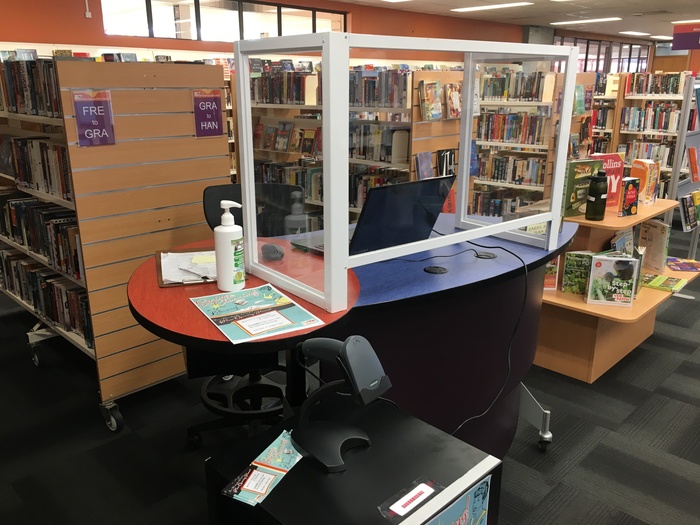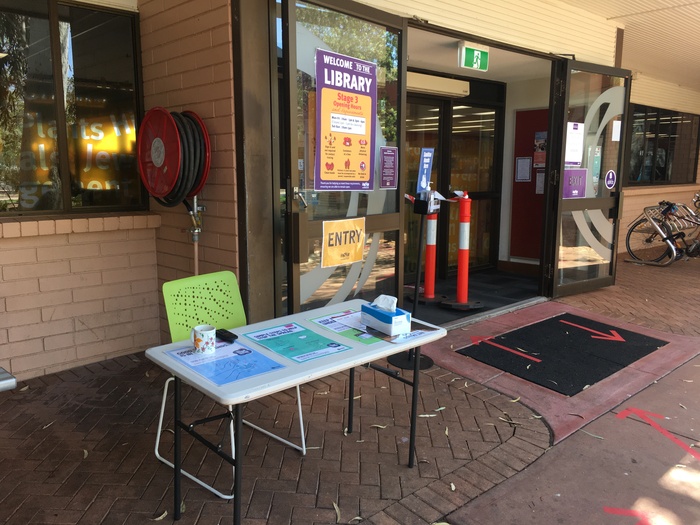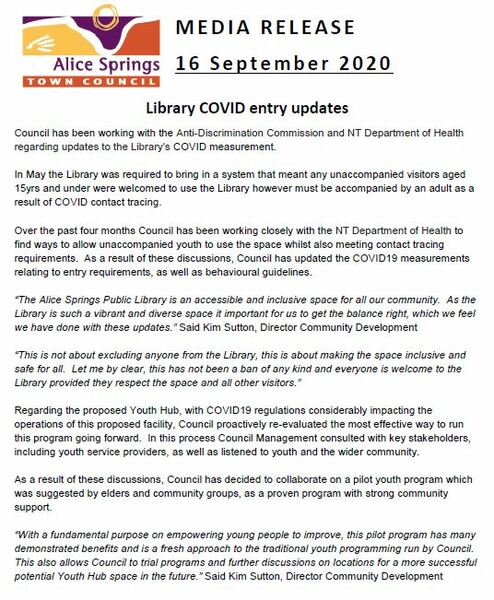Gabriel Curtin
March 2021
You can not exclude unless you assume you already own.
— Aileen Moreton-Robinson
I noticed some great books, regularly borrowed, being weeded from the collection of the library where I work. When I asked the collections manager about them, he explained that borrowing history was only one factor in considering whether a book gets removed. He suggested that to understand collections management required a three-year university degree.
In most workplaces I have experienced there is a culture averse to lateral information sharing. Management diminishes staff members’ capacities to act by withholding information, consolidating their power. In the case of the collections manager, I was not informed of the rationale as to why items were being removed. Instead, the process itself was framed as beyond my qualifications, making my objections redundant.
Alice Springs Public Library’s (ASPL) top tier of management, the Alice Springs Town Council Executives (ASTCE), also work in this way. Since ASPL operations fall under the purview of the corporate branch of Alice Springs Town Council, over the past year the Director of Corporate Services and CEO of the Council have driven much of the policy that has affected ASPL. Significant decisions made concerning ASPL’s operation have not appeared to be developed or delivered in conjunction with other elected council members. When COVID-19 policies were first brought into effect at ASPL, staff resistance or concern was undermined and diminished.
Following a long tradition of legitimising racialised surveillance and normalising white possessive logics under the impetus of public hygiene, institutions globally are shoehorning opportunistic policy into existence under the cover provided by COVID-19. Government-issued health directives have a history of functioning to corroborate an ideal of self-regulation, simultaneously mandating which bodies are most adept at such regulation. As Saidiya Hartman (1997) reminds us when considering hygiene policies in the period immediately following formal emancipation:
The emphasis on hygiene expresses larger concerns about national well-being, since hygiene legitimated, if not invited, the policing of dwellings but also the setting of guidelines for marriage and other forms of social association, particularly those considered dangerous or destabilising of social order. Regulating hygiene or ensuring public health was a fundamental aspect of the police power of the state. (158)

Specific COVID-19 policies introduced at ASPL in 2020 included banning unaccompanied patrons aged 15 years and under, alongside a particular approach to contact tracing. When in place, to enter the library patrons had to submit their personal contact information by scanning their library card or, if they didn’t have one, providing the information verbally. A librarian was permanently stationed outside the entrance to the building to vet the age of prospective patrons and inform them of the contact tracing measures, while another librarian was stationed inside behind a desk equipped with sneeze guard, laptop, and barcode scanner, to procure the requisite contact information. The policies relating to the banning of unaccompanied youths and contract tracing were abruptly revoked on 28 September after mounting media pressure and a Northern Territory election in which several ASTC councillors ran.

ASTCE perform a frustrating loop when justifying banning unaccompanied youth as library patrons. In claiming that the policy was not based on race, but a consequence of the council’s duty to mitigate risk in relation to COVID-19, they wilfully ignored that, according to the ASTC’s 2018-19 annual report, 93 per cent of the unaccompanied library patrons accessing youth services at the library were First Nations people. No other library in the Northern Territory (NT) implemented similar measures, and no recommendations from government or health organisations identify young people as embodying a particular risk to the public. ASTCE’s explanation that their youth policy was a non-racialised risk mitigation strategy is at odds with these facts. When pressed on those inconsistencies ASTCE pursued an alternative explanation. In response to questions posed by local journalist Kieran Finnane, the CEO highlighted recent incidents of violence perpetrated by unaccompanied youth in the library as a means of legitimising the policy, implicitly acknowledging that the policy targets First Nations teenagers. A press release from ASTC regarding the reversal of the youth policy explained its implementation ‘as a result of contact tracing’. However, unaccompanied youth were banned from the library in May 2020, while contact tracing was not introduced until July 2020.

ASTCE’s youth policy is indicative of the conditional nature of liberal equality, which Wendy Brown (1995) reminds us
guarantees only that all individuals will be treated as if they were sovereign and isolated individuals. . . and that the state will regard us all as equally abstracted from the social powers constituting our existence, equally decontextualized from the unequal conditions of our lives. (110)
In settler-colonial Australia this conception of equality is part of an array of racialising processes undermining First Nations sovereignty and legitimating paternalistic policy. Contact tracing at ASPL was founded on abstract equality. It presumed the patrons accessing the library would uniformly understand the requirements to gain entry, have access to identification and enduring contact information, and suffer no negative reverberations between the tracing method and other methods of state surveillance. Failure to achieve that uniformity was recognised as a failure of individual personage, for which the patron wore responsibility by being denied access to the public library.
I have written this essay in Mparntwe on unceded Arrernte Country, Country upon which ASPL is also imposed. The town of Alice Springs is a locus for a wide array of Indigenous languages, the speakers of those languages constituting a significant portion of the Alice Springs public. For many ASPL patrons, English is their second, third, or fourth language, or they may not speak Standard Australian English (SAE) at all. The conditions for entry to ASPL had not been figured or resourced in a way that ensured transparent communication. These factors intensify what Jasbir K Puar (2007) describes as ‘affective resonance’, that is
how surveillance technologies activate, infect, vibrate, distribute, disseminate, disaggregate; in other words, how things feel, how sensations matter as much as if not more than how things appear, look, seem, are visible, or are cognitively known. (129)
What are the sensations in common between engaging with the police officer at the bottle shop and the librarian at the contact tracing desk? How do those sensations differ between racialised and non-racialised subjects? How has the COVID-19 crisis enabled the expansion of policing and surveillance into institutions not typically associated with such practices? The particular method of contact tracing implemented at ASPL failed to be sensitive to the libraries’ position as public space accessed by people with varied living circumstances. Former patrons of the library experiencing homelessness cited the contact tracing method as the reason they no longer felt comfortable accessing the library. Significant numbers of patrons left the library when confronted by the contact tracing desk. Others provided the name of a town camp or community in lieu of a fixed address to gain entry to the library.
In the latter scenario, it is difficult to imagine a Department of Health (DOH) employee visiting a town camp or remote community and thoroughly chasing up leads to locate the individual that listed the camp/community as their point of contact, in a way that ensures they are informed of their risk of exposure to COVID-19. Even when the contact tracing method was functioning as designed, it privileged citizens fluent in SAE, with permanent housing, familiar with bureaucratic processes, and without prior traumatic relationships with state surveillance. As Aileen Moreton-Robinson (2015) puts it, ‘Despite the apparent promise of open access and use, public spaces are predicated upon an assumption of objectivity and rationality, which values but no longer explicitly marks or names whiteness or maleness’ (36).
That same ‘objectivity and rationality’ that Moreton-Robinson describes can be thought of as part of the infrastructure that naturalises states of exception. Because a state of exception is conceptualised as temporary, its negative impacts are more easily accepted. The constant shifting of the rationale and policies by which the state of exception is legitimised allow the state itself to remain intact. Whether legitimised by terrorism, COVID-19, or violent outbreaks in a public library, the state of exception endorses the kind of thinking that suggests decisions adversely affecting a group of people in the present can be reconciled later. Since the state of exception is permanent, that reconciliation is perpetually displaced into the future.
The contact tracing method and the exclusion of unaccompanied youth were reliant on what David Graeber (2020) calls ‘structural violence’ (119). The ASTCE’s specific public health measures are enforced and enabled by the threat of physical violence. On 24 August I witnessed a 14-year-old ignore the librarian explaining why they were not permitted entry to ASPL and walk straight past the contact tracing desk. The 14-year-old did not comply with any librarian’s follow up attempts to get them to exit the library, resulting in Council rangers being summoned to escort them out of the library. If the 14-year-old had refused to comply with the rangers, force would have been summarily applied or the situation would have escalated until the police were called. These escalating measures of violence are understood as the logical response to what is a relatively minor transgression. The threat of violence is naturalised as a reasonable coercive measure.
The violence undergirding bureaucratic control systems, demonstrated in the 14-year-old patron’s method of removal, belies the settler’s pathological fear that since Australia was founded on dispossession, the settler too could be dispossessed of what they stole should they cede power, information, or resources. Moreton-Robinson (2015) reminds us that for this reason Indigenous sovereignty will always trouble white possessive logics by its very existence. The implementation and impact of ASTCE’s COVID-19 policies demonstrate a white possessive logic and a fear of dispossession. Abolition, as a collective practice grounded in dissolving the infrastructures that naturalise the defence of that logic, holds the principles capable of remedying inequitable practice at ASPL.
The state of exception and structural violence are twin forces at play in ASPL. Both play out according to white possessive logics, as preemptive defence mechanisms that culminate in state-sanctioned violence. The key institutions that legitimise and naturalise this mode of relating are prisons and police. Abolitionist thought and practice posits that by dismantling those systems the ground is cleared to reconstitute human relations everywhere, to implement rehabilitation and networks of care as alternatives to punishment and vengeance.
The foundation of ASTCE’s COVID-19 policies, whether concerning youth or contact tracing, is safety. Some variation of ‘safety is non-negotiable’ is doled out by executives in response to criticism levelled at them for the policy. Mariame Kaba argues that safety and security are distinct, though readily confused. Contra security, Kaba (2017) remarks that ‘[s]afety means something else, because you cannot have safety without strong, empathic relationships with others. You can have security without relationships but you cannot have safety – actual safety – without healthy relationships.’ The ASTCE’s COVID-19 policies obstruct relationship building, in the same way their management style undermines dissent, given that violence is a means by which ‘it is possible to have relatively predictable effects on the actions of a person about whom you understand nothing’ (Graeber 2012, 116).
The result of the reversal of these two policies means that contact tracing was made voluntary, essentially reserving its function, again, for people literate in and trusting of the process. From 30 November 2020, ASPL have been required, as per generalised NT Government policy, to reintroduce mandatory contact tracing. The renewed contact tracing method will rely on verbal communication of a patron’s details or the Territory Check-In app, which involves patrons scanning a QR code. The ASTCE’s ‘No School No Service’ policy still stands at the library, meaning unaccompanied patrons 15 years and under are not permitted entry during school hours, rendering the reversal more or less obsolete. In July 2020, four key staff members including the library manager were suspended following a letter voicing opposition to the youth policy signed by the majority of ASPL staff, and the entire team of library youth engagement staff had their employment terminated without warning (Finnane 2020). Considering that there are no apparent plans to rehire youth workers or revive the youth engagement officer’s role, and that the ban destroyed the relationships built between library staff and young patrons, former ASPL employee and senior Arrernte woman Sylvia Purrurle Neale’s (Gordon and Barwick 2020) answer to her own question is painfully pertinent: ‘What do the kids come back to? They’ll come back to nothing.’
Applying an abolitionist approach in the place of ASTCE’s policies would demand asking questions about what social infrastructure is lacking that requires people to seek necessities at the library. How do we reconfigure our conception of safety so that we might approach and include disruptive or sometimes violent individuals in public institutions? How might we develop models of conflict resolution that privilege the experiences of those involved in the conflict? How do we implement safety measures that do not diminish access for those community members who need the library most?
In their article ‘The Martyr Complex’ Alissa M. (2020) describes libraries as ‘public policy spakfilla.’ Libraries willingly or unwillingly attend to the gaps in social infrastructure, though rarely can they effectively cure the harms left by those gaps. Given this function, as well as striving to bring equitable access to information, resources and community, is it possible to imagine a library that serves the needs of the community as defined by the community itself? The rudimentary frame exists already, but it will take a major recalibration on the part of those controlling access.
When kids were still allowed in ASPL many of them would say ‘fuck this library’ in response to various requests from staff: be quiet, no running, final warning. Sometimes they’d say ‘fuck this library’ while being escorted out by a security guard or ranger. Yet they would, more or less, all show up the next day.
‘Fuck this library’ became a kind of catch cry among certain members of staff. It means fuck this library – fuck this library and the council that governs it, their violent management practices and possessive logics. But, also, fuck this library because we love it. Fuck this library because we believe in a better one. Fuck this library is a call to arms, a dirge, and a love poem.
Works Cited
Brown, Wendy. 1995. States of Injury: Power and Freedom in Late Modernity. New Jersey: Princeton University Press.
Finnane, Kieran. 2020. ‘Ongoing Discrimination at the Library.’ Alice Springs News. 1 September.
Gordon, Oliver and Barwick, Alex . 2020. ‘Alice Springs Council Reverses “Discriminatory” Policy, Lets Kids Back into the Library.’ ABC. 23 September.
Graeber, David. 2012. ‘Dead Zones of the Imagination: On Violence, Bureaucracy, and Interpretive labor.’ HAU: Journal of Ethnographic Theory, 2 (2): 105–128
Hartman, Saidya. 1997. Scenes of Subjection: Terror, Slavery, and Self-making in Nineteenth Century America.New York: Oxford University Press.
Kaba, Mariame and Duda, John. 2017. ‘Toward the Horizon of Abolition: A Conversation with Mariame Kaba.’ The Next System Project. 9 November.
M. Alissa. 2020. ‘The Martyr Complex.’ Cataloguing the Universe: A Work in Progress. 26 April.
Moreton-Robinson, Aileen. 2015. The White Possessive: Property, Power, And Indigenous Sovereignty.Minneapolis: University of Minnesota Press.
Puar, Jasbir K. 2007. Terrorist Assemblages: Homonationalism in Queer Times. Durham and London: Duke University Press.